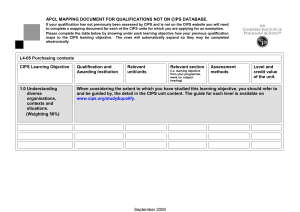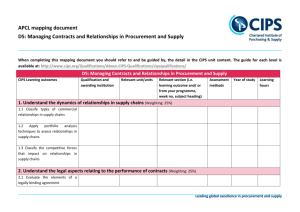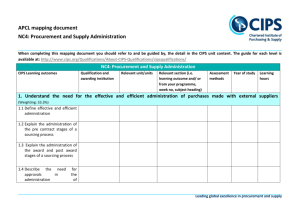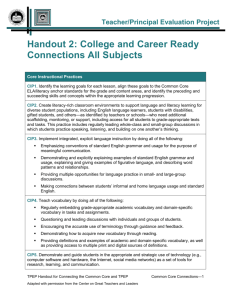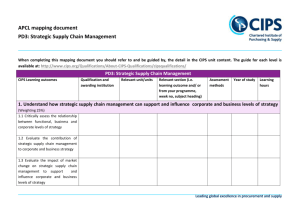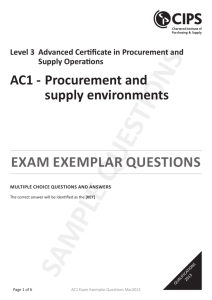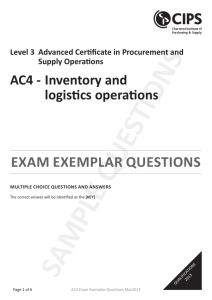Overview of This Training Module
advertisement
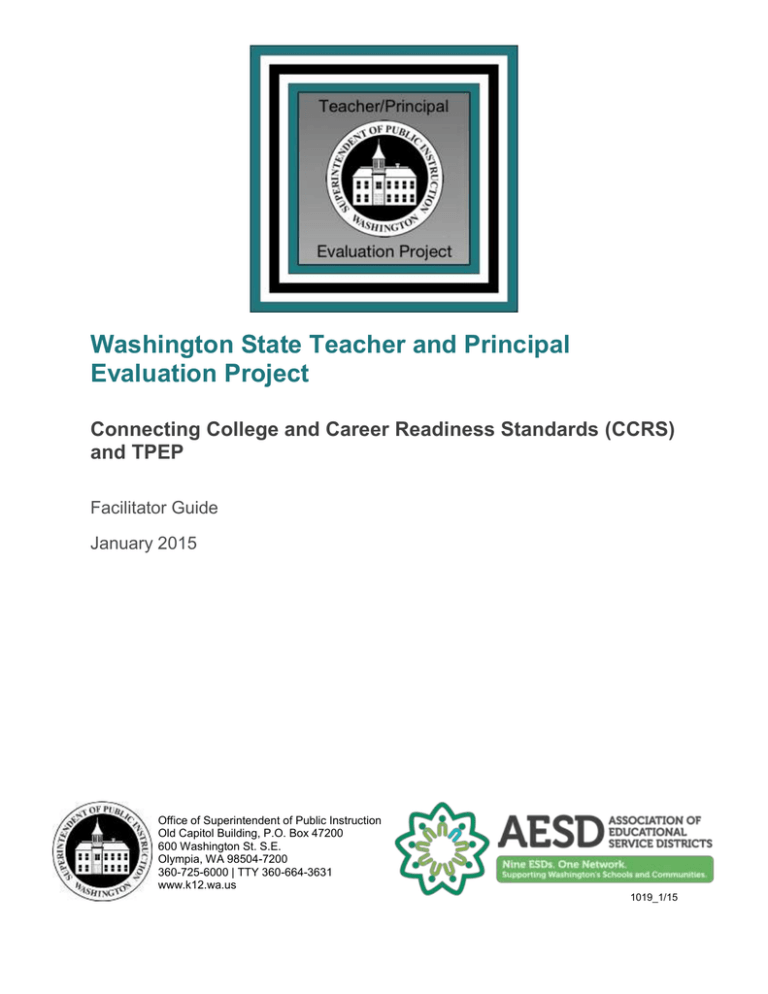
Washington State Teacher and Principal Evaluation Project Connecting College and Career Readiness Standards (CCRS) and TPEP Facilitator Guide January 2015 Office of Superintendent of Public Instruction Old Capitol Building, P.O. Box 47200 600 Washington St. S.E. Olympia, WA 98504-7200 360-725-6000 | TTY 360-664-3631 www.k12.wa.us 1019_1/15 Contents Overview of This Training Module ...................................................................................... 1 Audience......................................................................................................................... 2 Timing and Structure ...................................................................................................... 2 Preparing for the Session.................................................................................................... 4 Context ........................................................................................................................... 4 Agenda ........................................................................................................................... 4 Equipment and Materials ................................................................................................ 5 Participant Documents Needed................................................................................... 5 Work Session Supplies Needed .................................................................................. 5 Print Materials Needed ................................................................................................ 6 Preparation ..................................................................................................................... 7 Copies to Make Ahead of Time ................................................................................... 7 Posters to Make Ahead of Time .................................................................................. 7 Facilitator Guide ................................................................................................................. 8 Introductory Slide ............................................................................................................ 8 Connecting (Title Slide) ............................................................................................. 10 Learning 1: The Need for Creating Coherence (Title Slide) .......................................... 12 Learning 2: CIPs (Title Slide) ........................................................................................ 16 Implementing 1: Systems Review (Title Slide) ............................................................. 21 Implementing 2: Identifying Gaps and Action Planning................................................. 24 Reflection and Wrap-Up (Title Slide) ............................................................................ 26 Overview of This Training Module This training module—developed collaboratively by the Office of Superintendent of Public Instruction (OSPI), American Institutes for Research (AIR), and the nine Educational Service Districts—is designed to prepare school leadership teams for the deliberate alignment of teaching practices described in the instructional frameworks and the expectations of the College and Career Readiness Standards (CCRS) through the following intended outcomes: Build a shared understanding and language for addressing professional learning for CCRS, including the core instructional practices. Elucidate and strengthen the connections between the CCRS and district teacher evaluation systems. Identify any gaps in support for teachers’ instruction, and discuss concrete steps to address those gaps. This module takes an in-depth look at classroom instruction and teaching practice. It is not about understanding or implementing the mechanics of the teacher evaluation system and, as such, its format differs from the other modules developed to support TPEP. If you need support relating to the implementation of the teacher and principal evaluation systems, refer to the following TPEP evaluation modules (http://tpepwa.org/trainingpd/tpep-training-modules/): Introduction to Educator Evaluation in Washington Using Instructional and Leadership Frameworks in Educator Evaluation Preparing and Applying Formative Multiple Measures of Performance: An Introduction to Self-Assessment, Goal Setting, and Criterion Scoring Including Student Growth in Educator Evaluation Conducting High-Quality Observations and Maximizing Rater Agreement Providing High-Quality Feedback for Continuous Professional Growth and Development Combining Multiple Measures Into a Summative Rating This facilitator’s guide and the module materials are based on materials developed by the Center on Great Teachers and Leaders (GTL Center)—a federally funded technical assistance center created to support state-led initiatives to grow, respect, and retain great teachers and leaders for all learners. These materials have been modified in part with permission from the GTL Center. For more information about the GTL Center, visit www.gtlcenter.org. Facilitator Guide: Connecting the College and Career Readiness Standards and TPEP 1 Audience This module is intended for school district teams of 8 to 12 people, depending on the size of the district. OSPI highly recommends that each district team includes the following participants: Teacher leaders: They are critical to this module’s goals and the follow-up steps for the district team that develop as a result of the module. Principals: They need to understand both the instructional shifts discussed in this module and the coherence between the Common Core and the instructional frameworks that are part of TPEP. Central office staff: Select staff who have responsibility for curriculum and instruction, the Common Core, teacher evaluation and effectiveness, professional development, or some combination of these areas. This module may also be conducted with multiple teams from one school, one district team, or one school team. If multiple districts are participating in a session, there are facilitation tips embedded throughout the module that suggest possible modifications. Prior to the session, determine whether or not the audience uses the Fundamentals of Learning (FoLs) in their districts/schools. If they do not, facilitator notes throughout the presentation will identify which sections should be skipped. You should also use the handouts labeled “no FoLs” in the file name. Because there are several ways this module can be modified to fit the type of audience and to contextualize materials for the audience, please observe that the places in the facilitator’s guide where notes for these types of modifications are marked with the following icon ! Timing and Structure This module is designed to take a full day (6.5 hours), but it can be adapted to take three or four hours if needed. Instructions for modifying the interactive activities are included. The suggested “homework assignments” are intended to help participants extend, integrate, and apply their learning and are designed to take about an hour. This module is organized into four parts to help facilitators and participants pace the content appropriately. The four segments of each module are as follows: Connecting—Builds community, prepares the team for learning, and links to prior knowledge, other modules, and current work Learning—Describes key concepts and highlights various implementation scenarios; supports teams in applying knowledge and sharing ideas Implementing—Supports teams in problem solving and planning next steps for schools and districts Facilitator Guide: Connecting the College and Career Readiness Standards and TPEP 2 Reflecting—Engages participants in providing feedback, reflecting on learning, and closing the session This module is only intended to serve as an introduction and orientation for this topic. Districts should seek more in-depth training from other sources. Facilitator Guide: Connecting the College and Career Readiness Standards and TPEP 3 Preparing for the Session Context Participants will have varying levels of knowledge about the connections and alignment between the College and Career Readiness Standards (CCRS) and the instructional frameworks used in TPEP. Some may have spent a significant amount of time participating in training on the CCRS and instructional frameworks in the evaluation system; some may be deep into implementation of the CCRS, the instructional frameworks, or both the standards and the frameworks. Team members will also have differing levels of readiness to implement the tools and ideas in this module. ! The systems review section of the module can be significantly shortened based on the needs and timing of the session you are facilitating. You can adjust the time needed to work through the coherence process in the following ways: Review your summative data from last year’s evaluations to identify the instructional framework components with lots of staff in the “basic” category and then focus on one of those areas. Choose one or two “juicy” core instructional practices (CIPs) (e.g., number 3 for English Language Arts [ELA], number 5 for mathematics). Use the nine “generic” CIPs for alignment.These CIPs apply to all subjects. Select either ELA or mathematics CIPs. Determine which option you will pursue and adjust the PowerPoint slides accordingly. Agenda 1. Entry Task and Welcome (Total: 5 minutes) a. Entry Task: Three Reasons (3 minutes) b. Welcome, Introductions, and Norms (2 minutes) 2. Connecting (Total: 15 minutes) a. Connecting Activity: Four Corners (10 minutes) b. Connecting Wrap-Up and Debrief (5 minutes) 3. Learning I: The Need for Coherence (Total: 40–50 minutes, depending on which optional activity is used) a. Learning Content : The Standards and Special Issues Brief (10 minutes; optional activity 20 minutes) b. Learning Content: Key Content Shifts (15 minutes) c. Learning Activity: Teaching to the Standards and Debrief (15 minutes) Facilitator Guide: Connecting the College and Career Readiness Standards and TPEP 4 4. Learning 2: CIPs (Total: 65–105 minutes, depending on the number of CIPs used) a. Learning Content: CIPs (10 minutes) b. Learning Activity: Diving Into the CIPs (20 minutes) c. Learning Content: Fundamentals of Learning (5 minutes) d. Learning Activity: Aligning the CIPs and FoLs (20–60 minutes, depending on the number of CIPs used) e. Learning Wrap-Up and Debrief (10 minutes) 5. Lunch 6. Implementing I: Systems Review (Total: 65–140 minutes, depending on the number of CIPs) a. Implementing Content: The Coherence Protocol (10 minutes) b. Implementing Activity: Systems Alignment (45–120 minutes, depending on the number of CIPs) c. Implementing Wrap-Up and Debrief (10 minutes) 7. Implementing 2: Identifying Gaps and Action Planning (Total: 35–65 minutes, depending on whether or not the action planning is included in the session or as a “homework” assignment) a. Implementing Content: Implications Discussion (15 minutes) b. Implementing Activity: Planning and Next Steps (5 minutes, or 45 minutes if completed during the session) 8. Reflecting and Wrap-Up (5 minutes) Equipment and Materials Participant Documents Needed Ask participants to bring a copy (at least one per team) of the following document: The teacher evaluation professional practice framework or rubric in use at the district or school (Danielson’s Framework for Teaching, University of Washington’s Center for Educational Leadership [CEL] 5D+, or Marzano Teacher Evaluation Model) Work Session Supplies Needed Computer with slide presentation for this module Projector and screen Name table tents (optional) Poster paper (preferably the kind with adhesive backing; if not available, bring masking tape to post the paper on the wall) Facilitator Guide: Connecting the College and Career Readiness Standards and TPEP 5 Colored markers Self-sticking notes, 1.5 inches x 1.5 inches in one color Self-sticking notes, 3 inches x 5 inches in as many colors as you have teams Print Materials Needed Ensure that you have sufficient copies of the following materials: ! ! Handout 1: Implementing Career and College Readiness Standards in Washington State Handout 2: College and Career Ready Connections (select one of the following versions depending on your audience) Version 1—Empty (for districts that have their own CIPs) Version 2—All Subjects (for districts using the GTL Center’s CIPs) Version 3—ELA and Math Handout 3: Fundamentals of Learning Placemat Handout 4: Alignment Template (select one of the following depending on your audience) Alignment Template—All subjects (if targeting instructional practices that cut across content areas AND participants use the Fundamentals of Learning) Alignment Template—All subjects, no FOLs (if targeting instructional practices that cut across content areas but participants DO NOT use the Fundamentals of Learning) Alignment Template—Empty (if districts have their own set of CIPs AND they use the Fundamentals of Learning) Alignment Template—Empty, no FOLs (if districts have their own set of CIPs and they DO NOT use the Fundamentals of Learning) Alignment Template—ELA and Math (if using all the CIPs from the GTL Center AND participants use the Fundamentals of Learning) Alignment Template—ELA and Math, no FOLs (if using all the CIPs from the GTL Center and participants DO NOT use the Fundamentals of Learning) Handout 5: ELA/Literacy Anchor Standards and Mathematical Practice Standards (optional, to be placed on chairs or in folders) Handout 6: Coherence Protocol Handout 7: Action Planning Creating Coherence: Common Core State Standards, Teacher Evaluation, and Professional Learning (optional). You can print copies of the online version available at http://www.gtlcenter.org/sites/default/files/CreatingCoherence.pdf. Facilitator Guide: Connecting the College and Career Readiness Standards and TPEP 6 Preparation Copies to Make Ahead of Time Make copies of the materials listed under “Print Materials Needed” (noted previously). Posters to Make Ahead of Time For the Connecting Activity: Four Corners, create four posters, each with the name of a sport on it. Possible sports include baseball, basketball, golf, football, chess, swimming, rock climbing, flag football, and kick the can. Place each poster in a different corner of the room. For Slide 18 (Teaching to the Standards), create a poster on which participants can note common themes, big ideas, key words, or terms that are associated with the Common Core. For Slide 32 (Group Practice), create the following chart for L-CIP1. L-CIP1. Identify the learning goals for each lesson, align these goals with the Common Core ELA/literacy anchor standards for the grade and content areas, and identify the preceding and succeeding skills and concepts within the appropriate learning progression. Explicit Connections Implicit Connections For Slide 33 (System Alignment, Small Groups), write a CIP at the top of each piece of chart paper and then create two columns labeled “explicit” and “implicit.” If districts have their own CIPs, ask them to submit the CIPs to you ahead of time so that you can create the charts. If attendees all use a different framework, you will need to make duplicate sets of charts for each framework. (Create one chart for each CIP and insert CIP here.) Explicit Connections Fundamentals of Learning Implicit Connections Fundamentals of Learning Create a Parking Lot poster where participants can place self-sticking notes with their questions and feedback for the facilitator. Important Preparation Note Some slides, notes, and materials use “Common Core State Standards” in the text but the main focus is on College and Career Readiness Standards. There are facilitator notes later in this guide to point this out and address it. Facilitator Guide: Connecting the College and Career Readiness Standards and TPEP 7 Facilitator Guide Introductory Slide This slide will probably not be displayed as Slide 2 outlines an entry activity that participants can do while they get settled. Materials: 3 inch x 5 inch sticky notes for each group Handout 1: Implementing Career and College Readiness Standards in Washington State Chart paper Slide 1 Slide 2 is the entry task slide. During this slide, remind participants to complete the instructions on the slide. Ensure all district/school teams complete this task. Alternative activity for entry task (requires altering Slide 2 text): Draw a Venn diagram. Label one circle “CCRS” and one circle “TPEP.” What overlaps? What does not? Reference this activity during Slide 7 by asking people what’s different and similar, noting that, given the overlaps, we must bring coherence to these two reforms. Slide 2 Welcome participants, introduce yourself, and ask participants to briefly do the same with their first name and role. If the group is large, ask for a quick identification of district/school teams. Explain the logistics for today’s session (restrooms, food/beverages, etc.) This slide lists the agenda for the session. Explain: We will begin with a connecting activity to help build community, prepare everyone for learning, and link to prior knowledge and your current work. We will then transition to two interconnected learning segments, where the key concepts for this module are explained and you will Facilitator Guide: Connecting the College and Career Readiness Standards and TPEP Slide 3 8 have the opportunity to practice this coherence work. We’ll end with reflection and planning time so that we can determine concrete next steps. Explain: Let’s have a brief review of the norms for today’s session. [Read the norms on the slide.] Any comments about these norms? Any to add? Now, with these norms in mind, let’s get started with the module content. Slide 4 Explain: The outcomes for today’s session are as follows: [read slide]. Each segment of the session is aligned with one or more of these outcomes, and the divider “transition” slide between segments articulates those outcomes. Slide 5 Refer participants to Handout 1: Implementing the Career and College Readiness Standards in Washington State. Explain: Our overarching purpose is to ensure effective preparation for educators and students to implement the CCRS using a two-pronged approach. (Read bullet points 1 and 2.) Slide 6 Facilitator Guide: Connecting the College and Career Readiness Standards and TPEP 9 Explain: This module specifically addresses the ongoing phase identified on page 2 of Handout 1. This module will continue to deepen your knowledge of the standards and related teaching practices, as well as how to begin connecting the expectations across initiatives. This is a good place to note that in some places in this module we will use the CCRS terms and in other places Common Core State Standards (CCSS). With both, we are focused on the set of learning standards that will support ALL students to be ready for the future. Slide 7 Connecting (Title Slide) Materials: Four Corner posters in each corner of the room Slide 8 Explain: You may have noticed that around the room are four posters, each with the name of a different sport on it. I am going to read aloud a statement and ask you to move to the corner with the sport that most aligns with the statement I read. After you are in your corner, I’m going to ask you to talk with your group about why you picked that corner. You will have two minutes, then we’ll briefly discuss it as a whole group. Slide 9 [Check for understanding.] “Okay, we will be doing this twice, for two statements.” Facilitator Guide: Connecting the College and Career Readiness Standards and TPEP 10 Explain: Here is the first statement: “In my district, implementing the Common Core State Standards or (College and Career Readiness Standards) is like….” Ask participants to move to the corner with the sport that best represents their district situation. Remind them to talk in their group about why they picked that corner. While participants are in their four corners, encourage reluctant participants to talk by engaging them separately or brokering introductions. After about two minutes, have participants return to their seats. Next, call the group back to order and facilitate a share-out, with a representative from two sports discussing what each group talked about. Slide 10 Explain: Here is the second statement: “In my district, implementing the teacher evaluation system is like….” Again, ask participants to move to the corner with the sport that best represents their district situation. After about two minutes, have participants return to their seats. Call the group back to order and facilitate a share-out, with a representative from two sports discussing what each group talked about. Slide 11 After the activity, have participants return to their seats. Facilitator Guide: Connecting the College and Career Readiness Standards and TPEP 11 Learning 1: The Need for Creating Coherence (Title Slide) Slide 12 is the transition slide to the “learning” segment of the session. This segment focuses on building a shared understanding of the Common Core or CCRS and CIPs. Read the outcome on the slide to participants. Materials: Special Issues Brief: Creating Coherence Chart paper Explain: This brief and many of the materials for this module were developed by the Center on Great Teachers and Leaders. The GTL Center, as it’s known, is a federally funded national technical assistance center, created to support state-led initiatives to grow, respect, and retain great teachers and leaders for all learners. The focus for the national center’s work is the coherence between the Common Core and teacher evaluation, even though the brief talk discusses professional learning as well. This is one place in this session where we will use the language Common Core – because the GTL Center materials were developed that way. Slide 12 Slide 13 Due to time limitations, we will only read the first page so you can get a sense of what is contained in the brief. Allow participants 5 minutes to read. Optional: Have participants read pages 2–5 and 18–23 and discuss the following questions: Why is creating coherence important to teachers? How will this help our district/school? Let the participants know that the session will dig deeper into the CIPs and the alignment process highlighted in the brief. They are welcome to read the rest of the brief on their own. Facilitator Guide: Connecting the College and Career Readiness Standards and TPEP 12 Explain: The main idea of the graphic on this slide is to represent the purpose and need for creating coherence among multiple education reforms. The WA State Standards for student learning—in the circle—represent the destination. They describe where we want students to be by the time they graduate. Instruction—the big, green arrow—is the primary means for getting students to where they need to be. Slide 14 The purple and orange arrows—professional learning and teacher evaluation systems—ideally support instruction. They help lift and drive instruction toward the goal. This graphic represents the ideal situation, but in too many places these arrows are pointed in different directions and teachers receive incoherent messages about the best ways to teach. Alternatively, the arrows run parallel to each other, rather than reinforcing and leveraging each other. This is somewhat better but still problematic. So, as you engage in the work today, one of the goals is to understand and thoughtfully begin the alignment process between learning, evaluation, and support systems that support instruction for WA State Standard goals. For ELA/Literacy: Foundational skills like print concepts and alphabetic principle, phonological awareness, phonics and word recognition, and fluency. Although foundational skills are addressed prior to Grade 6, students who struggle in these areas will need further support. Reading literature and informational texts, such as a focus on teaching students reading skills to engage with rigorous texts across a broad spectrum of content, and balancing the types of texts students read. Facilitator Guide: Connecting the College and Career Readiness Standards and TPEP Slide 15 13 Literacy (reading and writing) in history/social studies, science, and other technical subjects, with a focus on teaching key ideas and details, using evidence from text to support conclusions, contextual vocabulary acquisition, and point of view. Writing standards, with a focus on teaching the processes of writing, including a balance of text types and the role of argument in history/social studies, and science Speaking and listening standards, with a focus on teaching the use of rhetorical and critical thinking in speaking, listening, and collaborative study, and workin comprehension and collaboration, presentation of knowledge and ideas, and evaluating the speaker’s point of view. Language standards that highlight teaching the conventions of standard English, knowledge of language in different contexts, and vocabulary acquisition. For Mathematics: The shift is more focused on building knowledge over time and linking knowledge grade by grade. This is also a strong focus on conceptual understanding, application, and fluency. For Science and Engineering: Explain: The science and engineering practices are geared around asking questions (for science) and defining problems (for engineering); developing and using models; planning and carrying out investigations; analyzing and interpreting data; using mathematics and computational thinking; constructing explanations (for science) and designing solutions (for engineering); engaging in arguments based on evidence; and obtaining, evaluating, and communicating information. Slide 16 There are also crosscutting concepts, such as patterns; cause and effect; scale, proportion, and quantity; systems and system models; energy and Facilitator Guide: Connecting the College and Career Readiness Standards and TPEP 14 matter; structure and function; and stability and change. For the disciplinary core ideas, there is physical science, life science, earth and space science, engineering, technology, and applications of science. These last two slides have illustrated what is taught and how students can engage in the learning. However, our focus today is on the “how.” Allow participants a minute to read the quote and then ask them the following questions: What is the key idea here? How can we support the application of this knowledge across grades and subject areas? (Possible answers include building instructional knowledge and skill, promoting skills and constructivist learning, etc.) We need to make sure that we have highly effective educators who know HOW to teach the “what.” So, what does the “how” look like? We’re going to explore that for the next few minutes. Slide 17 Explain: We hear the phrase “teaching to the new standards or to the Common Core” frequently these days, but what does this mean? Ask participants to respond to the questions on the slide one at a time as you facilitate a 5-minute discussion about each one. Chart their responses to Question 1. Slide 18 Facilitator Guide: Connecting the College and Career Readiness Standards and TPEP 15 Explain: With the last question in mind, this graphic demonstrates that regardless of the standards in focus, all teachers in all subjects and grade levels are responsible for preparing students for college and careers. Sometimes, there is a greater focus on ELA or mathematics, but it’s important to keep in mind that when we’re talking about the “how,” we’re talking about it as it relates to ALL teachers. Later, we’ll be looking at this through the lens of the teacher observation rubric. The teacher observation rubric does not identify specific “hows” for different types of teacher. Instead, all teachers are held to the same expectations and that is what is underscored in this graphic. Slide 19 Learning 2: CIPs (Title Slide) Materials: Handout 2: College and Career Ready Connections (select the version appropriate for your audience) ! Handout 3: Fundamentals of Learning Placemat 1.5 inch x 1.5 inch sticky notes for each group Slide 20 Slide 20 is the transition slide to the second learning segment of the module. Remind the group of the purposes of this segment (listed on the slide). ! Facilitator Prep note: There are four ways to facilitate the next section, depending on what districts come to the table with and their needs: If districts have their own set of CIPs (i.e., Tahoma has their “big classroom 10” list), they should select some or all of these to use in the Alignment Template and Coherence Protocol. (Handout 2: Connections—Empty) Districts can engage in the alignment work Facilitator Guide: Connecting the College and Career Readiness Standards and TPEP 16 using the 10 ELA and 10 mathematics CIPs identified by the GTL Center. (Handout 2: Connections—ELA and Math) Districts can engage in the alignment work using the 10 ELA OR the 10 mathematics CIPs from the GTL Center. (Handout 2: Connections—ELA and Mathematics; remove the set you will not be using prior to printing.) Districts can engage in the alignment work using nine CIPs that are not content-specific. (This will only take an hour, depending on how many people are in the room and whether you divide up the CIPs between partners, trios, or small groups). (Handout 2: Connections—All subjects.) Regardless of which is used, the main purpose is to teach the process and protocol. Any CIPs can be applied now or later to the process and protocol. Ask participants to answer the question on the slide. Explain: Let’s be clear—there are a lot of instructional practices out there, and many districts have developed their own. Whatever is used, the bottom line is that a set of practices have been identified as the critical things teachers need to be doing in classrooms. The important thing is that we learn this process around coherence, which can be done with any set of CIPs. ! Facilitator Note: If you are not using the GTL Center’s CIPs, you will need to revise the slide. Facilitator Guide: Connecting the College and Career Readiness Standards and TPEP Slide 21 17 Facilitator Note: If you are using the GTL 20 CIPs, a subset of these CIPs, or the generic nine, use this slide and: Explain: The set of CIPs in this session was created by content experts from American Institutes for Research and reviewed by an external committee of Teachers Teacher educators Curriculum and assessment developers Slide 22 The CIPs we’ll be using today can be found on Handout 2. If you are not using the GTL Center’s CIPs, replace this slide with one of your own that explains what your district uses as CIPs, why, and how they were created or selected. ! Facilitator Note: If you are using the GTL 20 CIPs, a subset of these CIPs, or the generic nine, use this slide. Read the slide bullets. If you are not using the GTL Center’s CIPs, replace this slide with one of your own that explains what your district CIPs are not, so as to make clear how they should be used. ! Slide 23 ! Facilitator Note: If you want to shorten your session, you can skip this activity or do one or two CIPs as a whole group. Read the instructions on the slide and ask participants to complete the activity. Depending on the number of CIPs, provide 10–15 minutes for reading and highlighting, 5 minutes for table group reporting, and 5 minutes for wholegroup share-out. Facilitator Guide: Connecting the College and Career Readiness Standards and TPEP Slide 24 18 ! Facilitator Note: If a district does not use the Fundamentals of Learning, skip the next four slides. Explain: Perhaps you’re wondering how this all fits with the Fundamentals of Learning. The Fundamentals of Learning are different from the CIPs in that they outline what students are doing, not what the teacher is doing. The FoLs are also not content-specific, so they may seem to apply to more teachers than just the ELA and mathematics CIPs. However, it’s important that we take a bit of time to explore the connections between the two so that you understand how they interact. We are going to spend a few minutes looking at how the CIPs and the FoLs align with one another. ! Slide 25 Facilitator Note: You can shorten this activity by assigning a few specific CIPs to each group. Read the directions on the slide. Explain: Write each CIP on a sticky note. Determine through consensus which FoL aligns with the CIP and place the sticky note on the corresponding FoL. Jot down a few words that explain your rationale. You can reference Handout 2 as needed. Repeat this process for each CIP. Before you get started, let me show you an example. Slide 26 Click to bring up the next slide and explain that the yellow boxes are the sticky notes. When done, return to this slide so that the directions are up while groups are working. Facilitator Guide: Connecting the College and Career Readiness Standards and TPEP 19 Show this slide to participants as an example of what they will be doing for the activity on the previous slide. When done, pull up Slide 26 as a reference for the audience as they work through aligning their CIPs. Slide 27 When groups look like they are done (after about 15–20 minutes), ask them to share out their findings and respond to the questions on the slide. Explain: This activity helps us see that most of the CIPs apply to all content and grade-level teachers, even if they are written more for ELA and mathematics teachers. We can see that the practices teachers choose to engage in directly impact the types of activities and behaviors students engage in, and therefore their mastery of the CCRS. Slide 28 After lunch, we’ll engage in a hands-on exploration of the CIPs, the FoLs [if participants use them], and the teacher evaluation framework from your district. ! Facilitator Note: If you are not including lunch time, delete this slide or replace it with a break slide. Slide 29 Facilitator Guide: Connecting the College and Career Readiness Standards and TPEP 20 Implementing 1: Systems Review (Title Slide) ! Facilitator Note: If your audience does not use FoLs, participants will skip Step 4 of the protocol. Materials: Handout 4: Alignment Template Handout 5: WA Standards (if using) Handout 6: Coherence Protocol Chart paper and markers for each group Teacher Evaluation Rubric Pre-made Alignment Chart for whole group practice 3 inch x 5 inch sticky notes for each group Slide 30 Slide 30 is the introductory slide for the first “implementing” section. Remind participants of the outcome of this section by reading the outcome listed on the slide. You will need to decide if you are going to assign a specific set of CIPs for each team to work on or whether the entire group will work through all the CIPs. Typically, teams can get through five CIPs in an hour. You just need to ensure that all of the CIPs are distributed among the teams. ! ! If it is helpful, you can insert a slide after Slide 32 with a breakdown of which groups are working on which set of CIPs. Facilitator Guide: Connecting the College and Career Readiness Standards and TPEP 21 Explain: So now we’re going to practice using a protocol that will help us look for alignment between the framework and the CIPs. Read the steps on Handout 6: Coherence Protocol and explain that each group will have chart paper and markers to complete the steps as they work through the CIPs. Slide 31 Explain: So now we’re going to practice using the protocol together. We’ll use CIP 1 from ELA because really this CIP could be applied to any content area. After reading the CIP and the criterion, you’re going to look through your framework for places of explicit and implicit connections. I’ll give everyone about 10 minutes to look through their framework and find as many explicit and implicit connections as possible, and then we’ll call them out and discuss. Slide 32 Questions may arise about the differences between implicit and explicit, how far to stretch the definition of implicit (i.e., anything can be implicit because we can justify anything…), and so on. The groups just need to be in agreement on the answers to these questions before moving on to the next activity. Once participants are done, ask them to share and lead a discussion to obtain consensus. When consensus has been reached, jot down the components on 3 inch x 5 inch sticky notes and place them on the sample chart in the corresponding column. Explain: Okay, let’s move to Step 4 [if you’re doing it]. Go back to the alignment work we did earlier between the CIPs and the FoLs. In the last column of the chart, you will check off the FoLs that are aligned with that CIP. Let’s do that together now. Which FoLs would I check off on my template? [Jot the FoL on a sticky note and place on sample chart.] Facilitator Guide: Connecting the College and Career Readiness Standards and TPEP 22 For Step 5, you will look at the connections you identified and make a note of any gaps in the bottom row. Those will be revisited at the end of the day. When you complete one CIP, repeat these steps for the remaining CIPs. Any questions? Facilitator Note: You can decide if you’d like to ask participants to create chart paper versions of their alignment work or if working on their templates will suffice. Using chart paper can be helpful to identify trends across the room and determine whether there is general agreement on alignment. Adjust the slide as necessary. ! Explain: Identifying these implicit and explicit connections will be our focus for the next chunk of time in this session. Slide 33 Read the directions on the slide. Explain: With your partner, trio, or team, you will follow these steps, all of which we have just run through. Each group will place their connections on the corresponding charts around the room. Check in on progress every 30 minutes. Depending on time constraints and how you have divided the CIPs, you may need to adjust the time and assignment. You can also assign a set of primary CIPs to the teams and then a set of secondary CIPs to teams so that a mechanism is created for teams to “calibrate” a bit around the alignment work. For example: Team 1: Primary CIPs = 1 and 2; secondary CIPs= 3 and 4 Team 2: Primary CIPs = 3 and 4; secondary CIPs= 7 and 8 Team 3: Primary CIPs = 7 and 8; secondary CIPs = 1 and 2 Facilitator Guide: Connecting the College and Career Readiness Standards and TPEP 23 Make sure all chart papers are posted on the walls and can easily be seen by the whole group. When teams have completed their work, engage the whole group in a discussion about what is reflected on the chart paper using the questions on the slide. Chart their responses on a blank piece of chart paper. Explain: Now that we’ve identified some trends, let’s talk about the implications of those trends and then what we might do about them. Slide 34 Implementing 2: Identifying Gaps and Action Planning Read the outcome on the slide to draw participant attention to the purpose of this section. Slide 35 Materials: Handout 7: Action Planning Handout 4: Alignment Template (completed) Chart paper and markers for each group Special Issues Brief: Creating Coherence (optional) As the team moves from discussing trends to discussing the implications of those trends, engage them in a whole-group discussion about implications using the questions on the slide. Slide 36 Teams or table groups will chart responses on blank chart paper. Facilitator Guide: Connecting the College and Career Readiness Standards and TPEP 24 Facilitator Note: If you are shortening your session, you can assign the action planning for “homework.” You will want to review the slides, but then you can assign the work to participants to complete later. ! Ask the group(s) to turn to pages 15–17 in the Special Issues Brief for an overview of next steps to consider. Ideas might include the following (taken from the GTL Special Issues Brief): Teacher Evaluation. Possible strategies to create more coherence between the Common Core and the professional practice framework include creating supplemental guidance to make the connections between the CCRS and teacher evaluation more explicit, adding clarifying language or “look-fors” to the framework for some or all teachers, and modifying the framework language. Slide 37 Explain: When determining a course of action for addressing each gap in alignment, consider whether the CIP pertains to teachers of specific grade levels or subjects, or whether it is a critical practice for all teachers to incorporate into their approach. Second, consider how any change might impact the reliability and validity of the framework. (Any significant change to the framework language will require revalidation of the tool.) Finally, consider all potential changes from a usability standpoint: Does adding language to the framework make it more complicated and harder to use? For specific suggestions, see “Guiding Principles for Modifying Professional Practice Frameworks” (page 17 of the brief). Your team might also find pages 23–25 useful. Now it is time for the whole group to engage in some planning. Use Handout 7: Action Planning and spend 30–45 minutes planning with your team. Facilitator Guide: Connecting the College and Career Readiness Standards and TPEP 25 Reflection and Wrap-Up (Title Slide) Slide 38 Review the outcomes for the session and get feedback (thumbs up, sideways, or down) from the audience. Slide 39 Ask participants to share a few comments on two sticky notes, using the prompts on the slide. Thank the participants for coming and make sure you have shared your e-mail address and other contact information on this slide so that they can get in touch regarding any follow-up questions. Slide 40 Facilitator Guide: Connecting the College and Career Readiness Standards and TPEP 26 Reference slide Slide 41 Facilitator Guide: Connecting the College and Career Readiness Standards and TPEP 27
